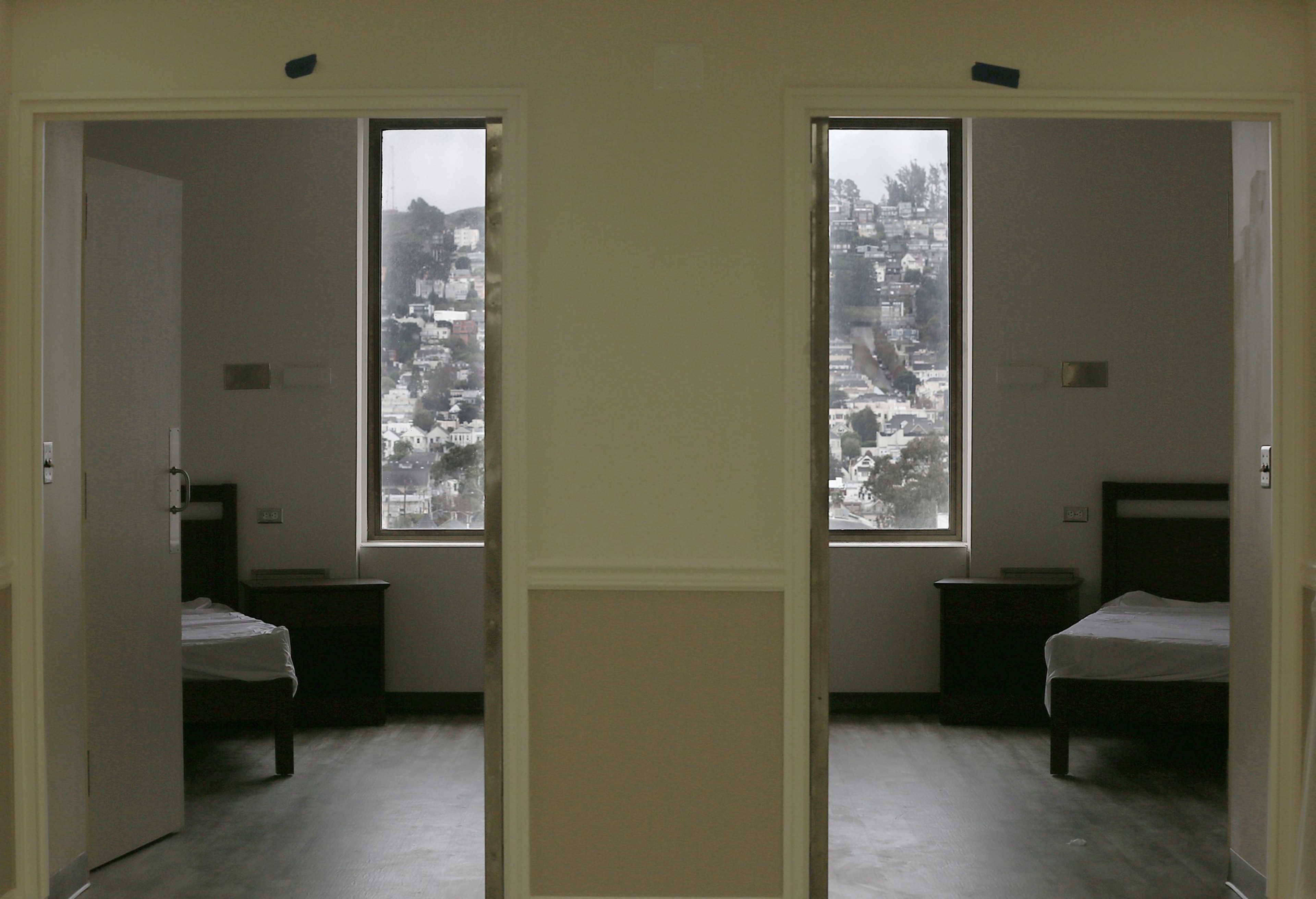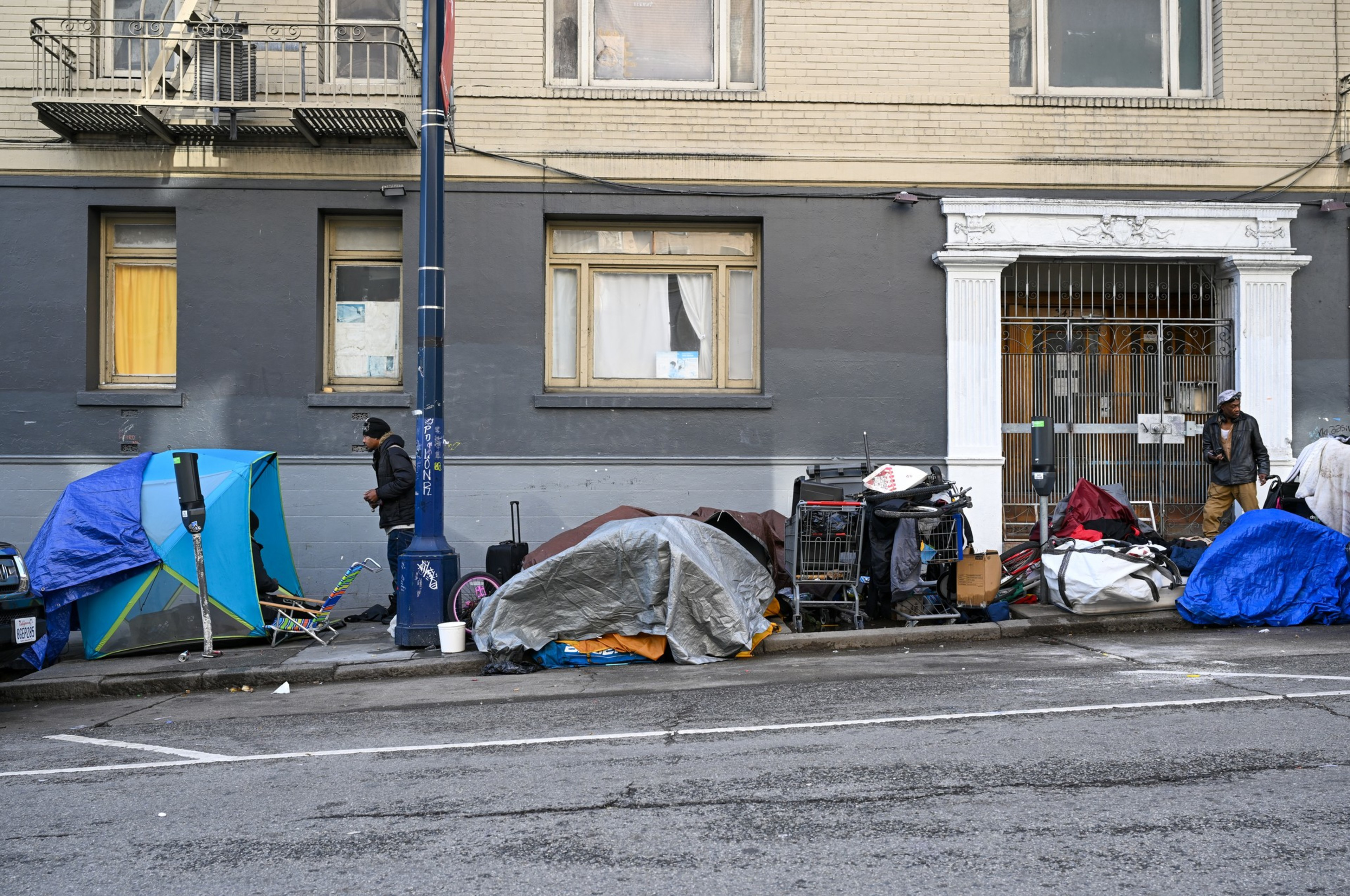After allegedly committing two sexual assaults inside a San Francisco mental health facility, a man deemed too mentally ill to stand trial was quietly released this month to a transitional home not designed for psychiatric patients.
Gilberto Lopez-Duarte, 37, had been discharged from the locked ward at Zuckerberg San Francisco General Hospital three months after being expelled in July from the Crestwood Healing Center, a locked psychiatric clinic that refused to take him back.
Eight days after his latest release, police arrested him again at the Hayes Valley transitional housing where he had been sent, on suspicion of drug possession and another sexual assault. He has pleaded not guilty to the charges.
The case of Lopez-Duarte reveals a fundamental flaw in California’s patchwork mental health safety net: When private psychiatric facilities refuse to house high-risk or violent patients, even those in need of intensive supervision can easily fall through the cracks, end up back on the streets, and sometimes back in jail.
Since 2022, Lopez-Duarte has been living under involuntary conservatorship, giving San Francisco officials control over his medical and housing decisions, since he is incapable of caring for himself. His county conservator had placed him at the taxpayer-funded, but privately operated, Crestwood Healing Center, where he was meant to get intensive care in a secure facility.
But in July, Crestwood expelled Lopez-Duarte after staff accused him of assaulting another patient. With no other locked facilities willing to accept him, his conservator kept him for several months in San Francisco General Hospital’s secure psychiatric ward while searching for alternatives.
On Oct. 2, officials approved his transfer to an unlocked transitional housing site, one meant for the formerly homeless rather than the severely mentally ill. Eight days later, on Oct. 10, Lopez-Duarte was booked into the county jail again.
This sequence of events — from his July expulsion from Crestwood to his October release to his rapid rearrest — illustrates how the current system struggles to manage patients deemed too dangerous for freedom, yet too difficult to treat.

Lopez-Duarte could not be kept indefinitely in the city’s secure mental ward at the hospital or in jail, because he’d been found unfit to stand trial following allegations that he committed felony assault and elder abuse in 2021.
If his history is any indication, Lopez-Duarte likely won’t be able to stand trial on his most recent charge either, leading him right back into the system that let him go.
Time at Crestwood
In two separate stints lasting about a year, Lopez-Duarte lived at Crestwood Healing Center, a reputedly high-security psychiatric clinic inside St. Mary’s Hospital on Stanyan Street, which has a troubling track record of patients going AWOL.
A 2024-25 state review of the facility (opens in new tab) found that Crestwood failed to document patients’ whereabouts. The facility was also cited for failing to have enough trained staff to plan for client rehabilitation or to obtain criminal background checks for its workers.
On June 6, 2024, records say, Crestwood staff told police that Lopez-Duarte had sexually assaulted another patient. Lopez-Duarte was arrested by San Francisco Police Department officers and put in jail, but prosecutors declined to file charges. He was released back into the public and wandered the streets before showing up at his mother’s house, according to an internal report.
His mother convinced him to go voluntarily to SF General, where he told doctors he didn’t assault the woman at Crestwood. “I don’t understand why she is accusing me because she consented,” he said in one of his daily check-ins with doctors.
For nearly a year, he remained in the general hospital’s locked ward. Then, according to a recent medical evaluation in March of this year, he returned to Crestwood under conditions that included no sexual contact with other patients.
“I can’t believe they can’t find another locked facility to put him. There should be a backup plan for those patients that the private entities won’t accept.”
Ira Barg, former Assistant District Attorney
Apparently, he soon broke that pledge. On July 2, 2025, police arrived to interview another alleged sexual-assault victim, who said the encounter was consensual.
Crestwood staff disagreed, saying that the victim was “very delusional and unable to consent to sex.” When confronted about his alleged behavior, Lopez-Duarte “became argumentative and aggressive,” according to Department of Public Health records shared with The Standard. “He denied that he agreed not to have sex while at the facility, and told staff to ‘go to hell.’”
Days later, Lopez-Duarte was again discharged from Crestwood and barred from returning.
Too dangerous for freedom?
After Lopez-Duarte’s expulsion, his city conservator faced an ugly reality: No high-security mental health facility would take him.
The overcrowded state hospital system, which holds a small number of the most dangerous and mentally ill patients, handles only a fraction of the state’s cases. The vast majority are cared for by counties. Oftentimes, the last secure location for people like Lopez-Duarte are facilities like the one where he was accused of harming other patients.
Under state law, even those facilities are designed to eventually release patients like Lopez-Duarte, once they are stabilized. Very few people remain there long-term.

Medical reports show Lopez-Duarte often refuses to take his antipsychotic medication and has a history of becoming mentally unstable and turning to drugs when on the streets.
Ultimately, after a judge was notified by his conservator that he no longer needed to be in a locked facility, officials placed him in unlocked transitional housing.
Lopez-Duarte’s conservator — who has legal responsibility for his care — said patients released into such housing “continue to receive intensive wraparound care, including case management, medication monitoring, and clinical oversight to ensure stability and safety.” For some, the conservator added, that includes “long-acting injectable medications or regular blood tests to confirm medication adherence.”
In Lopez-Duarte’s case, that care did not appear to prevent him from getting his hands on more drugs and falling back into the criminal justice system.
Lawyers who have dealt with such cases argue that Lopez-Duarte illustrates a system that lets people fall through the cracks.
“I can’t believe they can’t find another locked facility to put him,” said former Assistant District Attorney Ira Barg, who handled conservatorship cases. “There should be a backup plan for those patients that the private entities won’t accept.”
A less-than-perfect system
The example of Lopez-Duarte isn’t unique. It illustrates a broader problem in California’s fragmented mental health system, which relies on a patchwork of public and private care.
The state operates five mental hospitals, but those beds have long wait lists and are typically reserved for the most extreme cases.
Defendants like Lopez-Duarte can only be held in the state hospital for two years while its staff tries to return people to a level of competency to stand trial. Once the hospital staff decides a patient can’t be returned to a mentally stable state sufficient for trial, that patient usually returns to the county where they were charged.
Counties like San Francisco are responsible for these people, including roughly 700 who are under involuntary conservatorship by the city because they are mentally ill or drug addicted. Once in conservatorship, many patients are moved to facilities like Crestwood. Under state law, patients must be kept in the least restrictive settings.

But when private facilities refuse to take them, counties often have nowhere else to turn.
The Human Services Agency, which oversees the Public Conservator’s office, and the Department of Public Health, said in a joint statement that they could not comment on any specific case. But they acknowledged the system’s shortcomings and said that the city is attempting to expand the number of beds for troubled patients.
“The current system is … hard to navigate without enough treatment capacity,” the agencies said in a statement.“The demand for locked mental health beds for conserved clients with complex and severe mental health challenges remains.”
A lawyer who has dealt with conservatorship cases, who asked to remain anonymous, said reform needs to come from the top. Either the state should expand its hospitals to handle more high-risk patients, or it should change the law so private contractors like Crestwood cannot refuse them.
Crestwood declined to comment on Lopez-Duarte’s case.
The Public Defender’s Office, which represented Lopez-Duarte in both of his recent criminal cases, said it could not comment on any specific case. It said stereotypes or narratives about the mentally ill make it difficult to get people the care they need.
Nevertheless, it added in a statement: “Until we have a robust network of care — by investing more in public healthcare, rather than in more policing and incarceration — individuals who are gravely disabled, their families, and our communities will continue to suffer.”
A merry-go-round
San Francisco-raised Lopez-Duarte has a long history of cycling in and out of the city’s criminal justice and mental health systems.
According to medical records, he suffered a severe head injury after being struck with a bat in 2017, and his mental health has unraveled since then. The records show he has overdosed more than once, has repeatedly been placed on involuntary mental-health holds, and has been sent to the state mental hospital.
Estranged from his family in San Francisco, Lopez-Duarte has also been homeless for years.
In April 2021, he was charged with felony assault and elder abuse but deemed mentally incompetent to stand trial. The judge ordered him to Napa State Hospital, giving doctors two years to restore him to competency.
But the state’s hospital system was overwhelmed, and Lopez-Duarte languished on a wait list for eight months before being admitted in December 2021. Less than a year later, hospital staff concluded they could not restore him to competency and sent him back to San Francisco. The assault and elder abuse charge was later dismissed after he was placed in conservatorship.
Psychiatric evaluations from the time describe him as paranoid and volatile. A doctor wrote that Lopez-Duarte exposed himself to others multiple times, and also had suicidal thoughts, including hearing the “voice of Lucifer” who “told him to kill himself.”
In October 2022, a mental health evaluator recommended Lopez-Duarte for an involuntary conservatorship in a locked facility due to an alleged refusal to cooperate with treatment, a track record of fleeing unlocked facilities, and an inability to care for himself.
“He typically becomes homeless and his psychiatric symptoms become more significantly decomposed,” the doctor wrote in the report, adding that Lopez-Duarte often turns to drugs and alcohol, increasing his chances of committing crimes.
It wasn’t until nearly a year later, in September 2023, that he was finally sent to Crestwood. An investigation by The Standard this summer found that 20 patients had gone missing from the facility over the past three years.
“The current system is … hard to navigate without enough treatment capacity. The demand for locked mental health beds for conserved clients with complex and severe mental health challenges remains.”
The Human Services Agency and the Department of Public Health
Regardless of such issues, Lopez-Duarte’s sister thinks he should be in a locked facility because he needs very special help and has a record of escaping unsecure facilities and failing to take his medication.
“It’s very sad,” Maria Duarte said in an interview in Spanish. “He needs a lot of help and love.”
Despite her wishes and the recommendations of his initial mental health assessment, he was not returned to a locked facility.
Instead, on Oct. 2, he was released to a transitional housing facility in the city. The public-private facility at 33 Gough Street was built to house the formerly homeless, not the mentally ill. A recent document about Lopez-Duarte’s case said he was on a plan of ongoing care and “requires intensive case management.”
But there are no guards at the site, and residents are free to come and go as they please. It was simply another way station in a system that has too few beds, too few resources, and too few answers for people like Lopez-Duarte.
Only a few days later, he ended up back in jail, at the beginning of yet another broken cycle. Lopez-Duarte appeared in court on Wednesday afternoon, where he denied the charges and pleaded not guilty.
His appointed public defender asked that he be released — back into SF General — until another locked facility could be found.
But Judge Marie Evangelista denied the request and ordered him to stay in jail, pointing out that in addition to this charge and an arrest for alleged rape in 2020, he has seven arrests for indecent exposure from 2015 to 2019 and another such arrest out of Butte County.
“His conservatorship is flatly ineffective,” said Assistant District Attorney Blake Hyde. “He cannot be released in any capacity.”

